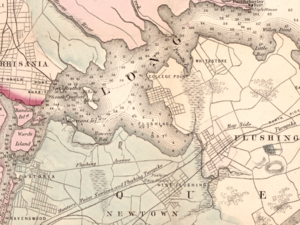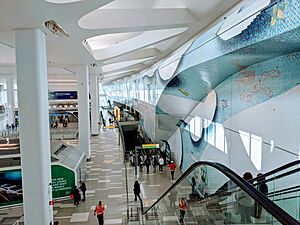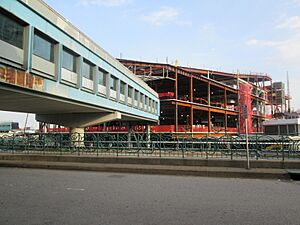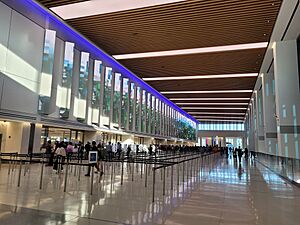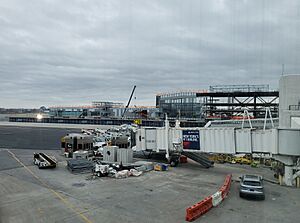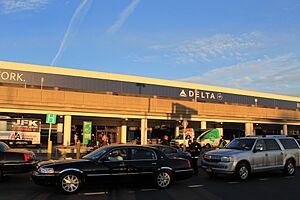LaGuardia Airport facts for kids
Quick facts for kids
LaGuardia Airport
|
|||||||||||||||
|---|---|---|---|---|---|---|---|---|---|---|---|---|---|---|---|
 |
|||||||||||||||
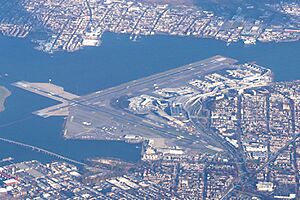
Aerial view in 2021
|
|||||||||||||||
| Summary | |||||||||||||||
| Airport type | Public | ||||||||||||||
| Owner/Operator | Port Authority of New York and New Jersey | ||||||||||||||
| Serves | New York metropolitan area | ||||||||||||||
| Location | East Elmhurst, Queens, New York City, U.S. | ||||||||||||||
| Opened | December 2, 1939 | ||||||||||||||
| Hub for | |||||||||||||||
| Time zone | EST (UTC−05:00) | ||||||||||||||
| • Summer (DST) | EDT (UTC−04:00) | ||||||||||||||
| Elevation AMSL | 6 m / 21 ft | ||||||||||||||
| Coordinates | 40°46′30″N 73°52′30″W / 40.775°N 73.875°W | ||||||||||||||
| Map | |||||||||||||||
FAA airport diagram |
|||||||||||||||
| Runway | |||||||||||||||
|
|||||||||||||||
| [[Helipad|]] | |||||||||||||||
|
|||||||||||||||
| Statistics (2024) | |||||||||||||||
|
|||||||||||||||
|
Source: Port Authority of New York and New Jersey
|
|||||||||||||||
LaGuardia Airport (often called LaGuardia or LGA) is a busy airport in East Elmhurst, Queens, New York City. It sits on the northwestern shore of Long Island, next to Flushing Bay. The airport covers about 680 acres and first opened to the public in 1939. It is named after Fiorello La Guardia, who was a mayor of New York City.
LaGuardia Airport mainly handles flights within the United States, but it also has some international flights. In 2023, it was the third busiest airport in the New York metropolitan area. It was also the 19th busiest airport in the entire United States based on how many passengers it served.
The airport is a major hub for American Airlines and Delta Air Lines. A "hub" is a central airport where an airline connects many flights. LaGuardia has special rules, including a "perimeter rule" that stops most direct flights to places farther than 1,500 miles away.
For many years, LaGuardia was criticized for being old and inefficient. Because of this, the Port Authority of New York and New Jersey started a huge project in 2015 to rebuild the airport. This big reconstruction project was finished in January 2025.
Contents
Airport History
Early Days of the Site
Before the airport was built, the area was a natural point where two bays met. In the late 1800s, a summer resort called Bowery Bay Beach opened here. It was later renamed North Beach and grew to include an amusement park.
However, times changed. Rules like Prohibition in the United States and anti-German feelings during wars made it hard for the resort to make money. Also, more factories and pollution made the area less appealing for fun. The resort was eventually closed in the 1920s.
From Seaplane Base to Airport
In 1929, a company planned to open a private seaplane base at North Beach. It opened on June 15 and had a concrete area for seaplanes to land and a ramp to the water. The old resort buildings were used as a passenger terminal.
The new airport held air races and started offering flights to other cities. One month later, flights to Boston began.
Becoming Glenn H. Curtiss Airport
By 1930, the airport had improved with hangars and lighted runways for night flights. On September 23, it was renamed Glenn H. Curtiss Airport to honor a famous New York aviation pioneer.
In 1931, the airport welcomed the Dornier Do X, which was the world's largest airplane at the time. It had flown across the Atlantic Ocean for 10 months. Over 18,000 people visited the huge plane on its first day. This showed that long-distance air travel to New York City was possible.
Mayor La Guardia's Vision
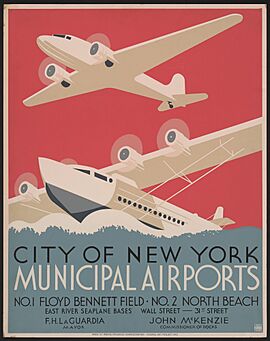
When Fiorello La Guardia became mayor in 1934, he wanted New York City to have its own main airport. He had always supported aviation. He believed the city needed a central airport to handle its growing air traffic.
LaGuardia saw the potential in Curtiss Airport. In 1935, the city leased the airport for $1 a year. It was officially named Municipal Airport 2. Mayor LaGuardia worked hard to bring major airlines to New York City directly, instead of them using airports in nearby states.
The Birth of LaGuardia Airport
The idea to build a major airport in Queens came after Mayor La Guardia had a strong reaction at Newark Airport. His flight ticket said "New York," but he landed in New Jersey. He demanded to be flown to a New York City airport, Floyd Bennett Field in Brooklyn. He then told reporters that New Yorkers needed an airport in their own city.
American Airlines tried flying from Floyd Bennett Field, but it was too far from Manhattan. So, LaGuardia and American Airlines started planning a new airport in Queens. This location was better because it was close to the new Queens–Midtown Tunnel to Manhattan.
Construction began in 1937. The airport was built on land filled in from Rikers Island, which was a garbage dump. The metal framework under the airport still affects airplane compasses today, so pilots are warned about it.
Because American Airlines helped a lot, they got extra space at the airport. They even opened the world's first private airline club there in 1939.
The airport was officially opened on October 15, 1939, as the New York Municipal Airport. It started operations on December 2, 1939. The small North Beach Airport became a huge, modern facility costing $23 million. Many people came to watch planes take off and land, paying a small fee. The airport quickly became a financial success.
Even before it was finished, major airlines agreed to use the new airport. During World War II, it was used for training aviation workers. The airport was officially named LaGuardia Airport on June 1, 1947.
Over time, LaGuardia became too small for the increasing air traffic. To help with overcrowding, a "perimeter rule" was put in place in 1984. This rule stops most direct flights to cities more than 1,500 miles away. This means longer flights usually use JFK or Newark.
In the early 2000s, LaGuardia often had long delays. After the September 11, 2001, terrorist attacks, air travel decreased, which helped reduce delays. Improvements to the airport's layout also made operations more efficient.
In 2006, a new, modern air traffic control tower was built, starting operations in 2010.
In 2011, Delta Air Lines announced plans to make LaGuardia a major hub. They greatly increased their flights and destinations from the airport.
Airport Redevelopment
In 2010, plans began to completely rebuild LaGuardia's main terminal. The goal was to create a modern, efficient airport. The project was expected to cost billions of dollars.
On July 27, 2015, Governor Andrew Cuomo and then-Vice President Joe Biden announced a $4 billion plan to rebuild the terminals. The idea was to create one connected building with bridges linking to the gates. The airport would also move 600 feet closer to the Grand Central Parkway, making more space for aircraft to move around.
Construction began in spring 2016. Terminal B was demolished and rebuilt, and Delta also rebuilt its terminals C and D. The new airport features an "island gate system," where passengers walk across bridges to reach their gates. These bridges are high enough for planes to taxi underneath.
The first part of the new Terminal B opened in December 2018 with new gates. More gates opened in June 2019. The main part of the new Terminal B opened in June 2020. The second bridge connecting to Terminal B was finished in January 2022.
On the east side of the airport, Delta combined its Terminals C and D into a new, central Terminal C. This new Terminal C opened in June 2022. It has a larger security area and Delta's biggest Sky Club. Delta sped up its construction due to the decrease in air travel during the COVID-19 pandemic.
In March 2024, LaGuardia won an award for being the "best airport of 25 to 40 million passengers in North America" in 2023.
Airport Operations
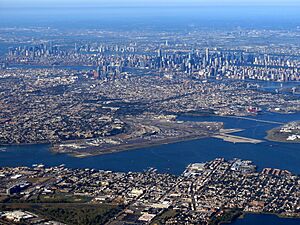
LaGuardia Airport mainly serves passenger flights to cities within the United States. It also has some international flights. Because it's a very busy airport near crowded neighborhoods, there are special rules for flights. LaGuardia mostly handles smaller, narrow-body aircraft.
Flight Rules
International Flights
LaGuardia does not have facilities for U.S. Customs and Border Protection (CBP). This means international flights can only arrive from airports that have "US border preclearance." Passengers on these flights go through immigration and customs checks at their departure airport. When they arrive at LaGuardia, they are treated like domestic travelers.
Curfew and Perimeter Rule
To reduce noise for nearby communities, LaGuardia has a "curfew." This means flights are generally not allowed between 12 AM and 6 AM during warmer months.
There is also a "perimeter rule" from 1984. This rule stops most direct flights to or from cities farther than 1,500 miles away. The only exception is flights to Denver, Colorado. This rule helps reduce noise from larger planes that need more fuel for long flights.
Slot System
LaGuardia is one of the busiest airports in the United States. To manage air traffic, it uses a "slot system." Airlines are given specific times for takeoffs and landings. This helps prevent too many planes from trying to use the airport at once.
Airport Facilities
Terminals
LaGuardia has three active terminals: A, B, and C. These terminals have a total of 72 gates. Buses and walkways connect all the terminals.
The airport has been undergoing a major redesign. This project resulted in a new Terminal B and a new Terminal C (which replaced the old Terminals C and D). Terminal A has had minor updates but remains largely the same.
Terminal A
Terminal A is also known as the Marine Air Terminal (MAT). It was the airport's first terminal for international flights. It was built to serve "flying boats" or Clippers, which were large seaplanes used by Pan American Airways. These planes would land in the water and taxi to a dock at the terminal. After 1947, flying boats stopped carrying passengers from New York.
Inside Terminal A, there is a large mural called Flight. It is 12 feet tall and 237 feet long. This mural, finished in 1942, shows the history of human flight. It was painted over in the 1950s but was restored and rededicated in 1980.
In 1986, Pan Am started using the MAT again for shuttle flights. Later, Delta Air Lines took over these flights. In 1995, the MAT was named a historic landmark. Today, Spirit Airlines and Frontier Airlines operate flights from Terminal A.
Terminal B
Terminal B serves airlines other than Spirit and Delta. It is a large hub for American Airlines. Construction on the new Terminal B started in 2017. The new terminal was designed to replace the older concourses.
The main building of the new Terminal B opened in 2020. It has bridges that connect to two new gate areas: the Western Concourse and the Eastern Concourse. The old Terminal B was demolished in 2022.
In 2021, JetBlue moved most of its flights to Terminal B to make connections easier with American Airlines.
Headhouse Floorplans:
| 4F | Bridges to/from Concourses | |
| 3F | Departures | Passenger drop-off, Ticketing and Check-in, Security, Parking |
| 2F | Arrivals | Baggage Claim, Car Services, Parking, Passenger pick-up, Taxis |
| 1F | Public Transit | Welcome Center, Hotel shuttles and Buses |
Western Concourse (Gates 11–31) Airlines that operate out of the Western Concourse include:
- American Airlines / American Eagle
Eastern Concourse (Gates 40–59) Airlines operating out of the Eastern Concourse include:
- Air Canada / Air Canada Express
- Frontier Airlines
- JetBlue
- Porter Airlines
- Southwest Airlines
- United Airlines / United Express
Terminal C
The new Terminal C, designed by Corgan, opened on June 4, 2022. It connects to four gate areas (concourses) that serve Delta Air Lines and Delta Connection flights. Three of these concourses are new, and one was updated. When finished, the new Terminal C will have 37 gates. It also has Delta's largest Sky Club.
Former Terminals
Old Terminal B (1964–2022)
The original Central Terminal Building (CTB) was dedicated on April 17, 1964. It had a central section and four concourses with 40 gates. Over the years, it was expanded and renovated. This terminal was replaced by the new Terminal B, and its final parts were demolished in early 2022.
Old Terminal C (1992–2022)
The original Terminal C opened on September 12, 1992. It housed some of Delta's operations. On June 4, 2022, the check-in and baggage claim areas of this terminal were closed. The eastern part of this terminal was demolished to make way for the new Concourse E.
Old Terminal D (1983–2022)
Terminal D opened on June 19, 1983. It was designed to handle larger aircraft. This terminal also housed Northwest Airlines until it merged with Delta in 2009.
As of June 4, 2022, Terminal D's check-in and baggage claim areas were closed. The central and eastern parts of Terminal D were demolished in September 2022. The western end of Terminal D remained open while the new Concourse F was built.
General Aviation
LaGuardia also handles "general aviation" aircraft, which are private or charter planes. There is a special area within the Marine Air Terminal (Terminal A) that provides services for these planes and their pilots.
After the September 11 attacks, rules for private planes at LaGuardia changed. Pilots flying non-scheduled flights now need to make a reservation in advance.
Other Facilities
The Port Authority Police Department (PAPD) provides law enforcement and emergency services at the airport.
Near runway 4, there is a public park called Planeview Park. It's a great spot for watching planes take off and land.
Airlines and Destinations
Passenger Flights
| Airlines | Destinations | Refs |
|---|---|---|
| Air Canada | Toronto–Pearson Seasonal: Montréal–Trudeau |
|
| Air Canada Express | Montréal–Trudeau, Toronto–Pearson | |
| American Airlines | Charlotte, Chicago–O'Hare, Dallas/Fort Worth, Miami, New Orleans, Orlando, Tampa, Washington–National Seasonal: Aruba, Bozeman, Calgary, Fort Lauderdale (resumes November 2, 2025), Fort Myers, Glacier Park/Kalispell, Raleigh/Durham, West Palm Beach |
|
| American Eagle | Asheville, Atlanta (resumes September 3, 2025), Boston, Buffalo, Burlington (VT) (resumes September 5, 2025), Charleston (SC), Charlottesville (VA), Cincinnati (ends September 2, 2025), Cleveland, Columbia (SC), Columbus–Glenn, Dayton (ends September 2, 2025), Des Moines, Detroit, Fayetteville/Bentonville, Greensboro, Greenville/Spartanburg, Indianapolis, Knoxville (ends November 1, 2025), Little Rock, Louisville (ends September 2, 2025), Madison (begins September 3, 2025), Memphis, Minneapolis/St. Paul (ends September 2, 2025), Nashville, Norfolk, Oklahoma City, Omaha (ends September 2, 2025), Pittsburgh, Portland (ME), Raleigh/Durham, Richmond, Roanoke, St. Louis, Toronto–Pearson, Tulsa, Washington–National, Wilmington (NC) Seasonal: Bangor, Grand Rapids, Halifax, Hyannis, Key West, Martha's Vineyard, Myrtle Beach, Montréal–Trudeau, Nantucket, Pensacola, Traverse City |
|
| Delta Air Lines | Atlanta, Boston, Charleston (SC), Chicago–O'Hare, Dallas/Fort Worth, Denver, Detroit, Fort Lauderdale, Fort Myers, Houston–Intercontinental, Kansas City, Miami, Minneapolis/St. Paul, New Orleans, Orlando, Sarasota, Tampa, West Palm Beach Seasonal: Bozeman (resumes December 20, 2025), Nashville, Nassau, Salt Lake City |
|
| Delta Connection | Albany, Asheville, Bangor, Birmingham (AL), Boston, Buffalo, Burlington (VT), Charleston (SC), Charlotte, Charlottesville (VA), Chattanooga, Cincinnati, Cleveland, Columbia (SC), Columbus–Glenn, Dayton, Des Moines, Fayetteville/Bentonville, Grand Rapids, Greensboro, Greenville/Spartanburg, Huntsville, Indianapolis, Jacksonville (FL), Knoxville, Lexington, Little Rock, Louisville, Madison, Memphis, Milwaukee, Montréal–Trudeau, Myrtle Beach, Nashville, Norfolk, Oklahoma City, Omaha, Pensacola, Pittsburgh, Portland (ME), Raleigh/Durham, Richmond, Roanoke, Rochester (NY), St. Louis, Savannah, Syracuse, Toronto–Pearson, Tulsa, Washington–National, Wilmington (NC), Worcester Seasonal: Halifax, Hilton Head, Key West, Martha's Vineyard, Nantucket, Panama City (FL), Traverse City |
|
| Frontier Airlines | Atlanta, Charlotte, Cleveland, Dallas/Fort Worth, Denver, Miami, Orlando, Raleigh/Durham | |
| JetBlue | Fort Lauderdale, Orlando, Tampa, West Palm Beach Seasonal: Nantucket |
|
| Porter Airlines | Toronto–Pearson | |
| Southwest Airlines | Atlanta, Chicago–Midway, Dallas–Love, Denver, Houston–Hobby, Kansas City, Nashville, New Orleans, St. Louis Seasonal: Orlando |
|
| Spirit Airlines | Atlanta, Charleston (SC), Charlotte, Chicago–O'Hare, Columbus–Glenn, Dallas/Fort Worth, Detroit, Fort Lauderdale, Houston–Intercontinental, Indianapolis (begins October 8, 2025), Miami, Myrtle Beach, Nashville, New Orleans, Norfolk, Orlando, Richmond | |
| United Airlines | Chicago–O'Hare, Denver, Houston–Intercontinental | |
| United Express | Washington–Dulles Seasonal: Chicago–O'Hare, Houston–Intercontinental |
Airport Statistics
Top Destinations
| Rank | City | Passengers | Airlines |
|---|---|---|---|
| 1 | 1,310,000 | American, Delta, Spirit, United | |
| 2 | 1,204,000 | Delta, Frontier, JetBlue, Southwest | |
| 3 | 876,000 | American, Delta, Frontier | |
| 4 | 847,000 | American, Delta, Spirit | |
| 5 | 776,000 | American, Delta, JetBlue, Southwest, Spirit | |
| 6 | 730,000 | Delta, JetBlue, Spirit | |
| 7 | 687,000 | American, Delta, Spirit | |
| 8 | 642,000 | Delta, Frontier, JetBlue, Southwest, United | |
| 9 | 541,000 | American, Delta, Spirit | |
| 10 | 532,000 | American, Delta, JetBlue |
| Rank | Airline | Passengers | Share |
|---|---|---|---|
| 1 | Delta Air Lines | 13,333,248 | 41.1% |
| 2 | American Airlines | 7,020,845 | 21.7% |
| 3 | JetBlue Airways | 3,355,603 | 10.4% |
| 4 | Southwest | 3,184,497 | 9.8% |
| 5 | United Airlines | 2,220,909 | 6.9% |
| 6 | Spirit Airlines | 1,927,934 | 5.9% |
| 7 | Air Canada | 927,817 | 2.9% |
| 8 | Frontier Airlines | 446,964 | 1.4% |
Annual Traffic
Annual Passenger Traffic at LGA
| Year | Passengers | Year | Passengers | Year | Passengers |
|---|---|---|---|---|---|
| 2002 | 21,986,679 | 2012 | 25,707,784 | 2022 | 29,093,792 |
| 2003 | 22,482,770 | 2013 | 26,671,755 | 2023 | 32,372,260 |
| 2004 | 24,453,203 | 2014 | 26,972,095 | 2024 | 33,543,943 |
| 2005 | 25,889,360 | 2015 | 28,437,668 | 2025 | |
| 2006 | 25,810,603 | 2016 | 29,786,861 | 2026 | |
| 2007 | 25,026,267 | 2017 | 29,562,228 | 2027 | |
| 2008 | 23,073,056 | 2018 | 30,082,127 | 2028 | |
| 2009 | 22,153,236 | 2019 | 31,084,894 | 2029 | |
| 2010 | 23,981,314 | 2020 | 8,245,192 | 2030 | |
| 2011 | 24,122,478 | 2021 | 15,601,033 | 2031 |
Getting To and From the Airport
Buses are the main way to get to and from LaGuardia Airport using public transportation. All terminals have public MTA bus lines. You can transfer to the New York City Subway for free if you use OMNY or MetroCard.
- M60 Select Bus Service (all terminals)
- Q33 (Terminal A only)
- Q70 "LaGuardia Link" Select Bus Service (all terminals except Terminal A)
- Q72 (all terminals except Terminal A)
- Q90 (all terminals except Terminal A)
There is also a free shuttle bus that connects all the terminals at the airport.
LaGuardia does not have a direct train connection, even though many ideas for one have been discussed. However, you can take a public bus or private car service to nearby subway or Long Island Rail Road (LIRR) stations.
The airport is mainly reached by car via the Grand Central Parkway. Taxis are available and use a meter. Ride-sharing services like Uber and Lyft also operate from designated areas. In 2019, a small fee was added to taxi and ride-share trips to help fund airport improvements.
Accidents and Incidents
See also
 In Spanish: Aeropuerto LaGuardia para niños
In Spanish: Aeropuerto LaGuardia para niños


